Konica Minolta DIMAGE MASTER LITE Manual
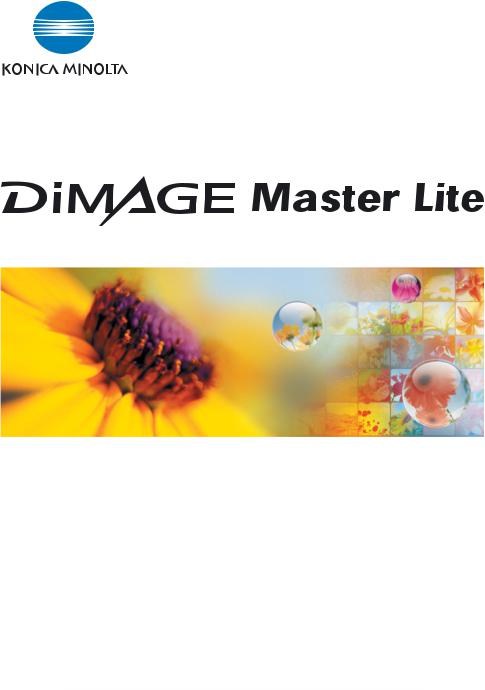
INSTRUCTION MANUAL

www.konicaminoltasupport.com
Konica Minolta Product Support Site, featuring access to a searchable Knowledgebase, Software and Hardware FAQs (Frequently Asked Questions), Software, Driver and Firmware Downloads, Telephone Support Information.
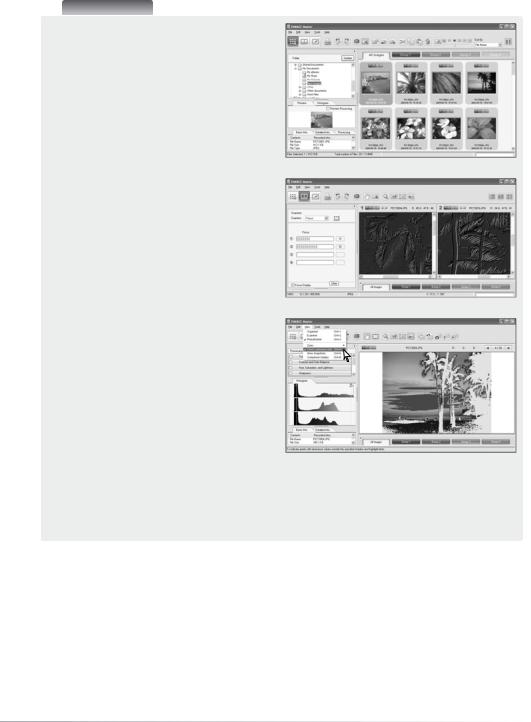
Master Notes
The full version of DiMAGE Master gives you all the tools to organize, examine, and process your images. The Organizer window allows you to sort images quickly into four user-defined classifications. Outtakes can easily be hidden from view without the need to delete or remove them from the folder.
Is it difficult to decide which image is the best? The Examiner window allows you to compare up to four images for differences between color, exposure, white balance, and focus by sampling areas in each image.
The Photofinisher window has many features to process large numbers of images quickly. Jobs can be created for specific adjustments and applied to other images as well as used for batch processing. Processing can be simply cut and pasted from one picture to another.
A luminance limit can be specified on the histogram and displayed on an image to show the pixels which are approaching the black and white levels. The focus checker enlarges the image so sharpness can be determined. These tools are available in the Organizer, Examiner, and Photofinisher.
Organizer
Focus Examiner
Photofinisher: Luminance Limit Display
For more on the other features in DiMAGE Master, visit us on the web at:
North America: http://kmpi.konicaminolta.us/
Europe: http://www.konicaminoltasupport.com
This instruction manual does not provide instruction in the basic operation of the personal computers or the basic operation of Windows or Macintosh operating systems; refer to the manuals supplied with the computer.
The examples in this manual use Windows XP software. The appearance of the screens may differ from the examples when using Macintosh or other Windows operating systems.
Every precaution has been taken to ensure the accuracy of this material. Contact Konica Minolta if you have any questions. Konica Minolta is not responsible for any loss or damage caused by the use of this software. This instruction manual may not be copied either in part or in its entirety without the prior permission of Konica Minolta.
1

TABLE OF CONTENTS |
|
|
1.0 Getting started ................................................................................................................................. |
3 |
|
1.1 |
Before installing the software ....................................................................................... |
3 |
1.2 |
Installing the software - Windows ................................................................................ |
4 |
1.3 |
Opening the software - Windows................................................................................. |
5 |
1.4 |
Installing the software - Macintosh .............................................................................. |
6 |
1.5 |
Opening the software - Macintosh............................................................................... |
7 |
2.0 Importing and editing images .......................................................................................................... |
8 |
|
2.1 |
Organizer window ......................................................................................................... |
8 |
2.2 |
Adjusting the window ................................................................................................... |
9 |
2.3 |
Loading image files ...................................................................................................... |
9 |
2.4 |
Preview and information tabs....................................................................................... |
9 |
2.5 |
Thumbnail size............................................................................................................ |
10 |
2.6 |
Sorting image files ...................................................................................................... |
10 |
2.7 |
Selecting thumbnails .................................................................................................. |
11 |
2.8 |
Selecting Favorites ..................................................................................................... |
12 |
2.9 |
Copying Favorites....................................................................................................... |
13 |
2.10 |
Downloading camera files .......................................................................................... |
14 |
2.11 |
Creating folders .......................................................................................................... |
14 |
2.12 |
Copy & move files to another folder .......................................................................... |
15 |
2.13 |
Cut, copy, paste, and delete - Windows.................................................................... |
16 |
2.14 |
Cut, copy, paste, and delete - Macintosh .................................................................. |
16 |
2.15 |
Renaming single files.................................................................................................. |
17 |
2.16 |
Renaming multiple files .............................................................................................. |
17 |
3.0 Basic image processing................................................................................................................. |
18 |
|
3.1 |
Photofinisher window ................................................................................................. |
18 |
3.2 |
Image display tools .................................................................................................... |
19 |
3.3 |
Rotate images ............................................................................................................ |
20 |
3.4 |
RGB display................................................................................................................ |
20 |
3.5 |
Tone processing ......................................................................................................... |
21 |
3.6 |
Contrast & color balance............................................................................................ |
22 |
3.6.1 |
Variation palette .......................................................................................................... |
22 |
3.7 |
An introduction to color.............................................................................................. |
23 |
3.8 |
Hue, saturation, and lightness.................................................................................... |
24 |
3.8.1 |
Variation palette .......................................................................................................... |
25 |
3.9 |
Comparison display.................................................................................................... |
26 |
3.10 |
Undoing image processing......................................................................................... |
26 |
3.11 |
Flip .............................................................................................................................. |
26 |
3.12 |
Resize ......................................................................................................................... |
27 |
3.13 |
Save ............................................................................................................................ |
28 |
3.14 |
Save as ....................................................................................................................... |
28 |
4.0 Printing |
.................................................................................................................................... |
29 |
4.1 |
Print - single ............................................................................................................... |
30 |
4.1.1 |
Print - multiple ............................................................................................................ |
32 |
5.0 Preferences |
.................................................................................................................................... |
34 |
5.1 |
Basic-information preferences ................................................................................... |
34 |
5.2 |
Application preferences.............................................................................................. |
35 |
6.0 Advanced Organizer ...................................................................................................................... |
37 |
|
6.1 |
Save image information.............................................................................................. |
37 |
6.2 |
Print index................................................................................................................... |
38 |
6.3 |
Batch processing........................................................................................................ |
40 |
6.4 |
Edit user note ............................................................................................................. |
41 |
6.5 |
Slide show .................................................................................................................. |
42 |
2TABLE OF CONTENTS
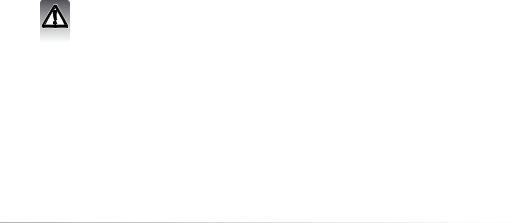
7.0 Advanced Photofinisher................................................................................................................. |
43 |
|
7.1 |
Processing tools ......................................................................................................... |
43 |
7.2 |
Tone curve and histogram .......................................................................................... |
44 |
7.3 |
Tone-curve processing guide ..................................................................................... |
46 |
7.4 |
Histogram processing guide ...................................................................................... |
48 |
7.5 |
White, black, and gray-point processing ................................................................... |
49 |
7.5.1 |
White and black-point values ..................................................................................... |
50 |
7.6 |
White balance (RAW only) .......................................................................................... |
50 |
7.7 |
Sharpness................................................................................................................... |
51 |
7.8 |
Filter effects ................................................................................................................ |
51 |
7.9 |
Color space selection (RAW only) .............................................................................. |
52 |
7.10 |
Imprint data ................................................................................................................ |
53 |
7.11 |
Area marquee ............................................................................................................. |
54 |
7.12 |
Snapshot .................................................................................................................... |
55 |
7.12.1 |
Print snapshots........................................................................................................... |
56 |
8.0 Color preferences .......................................................................................................................... |
58 |
|
8.1 |
Using monitor ICC profiles ......................................................................................... |
58 |
8.2 |
Using printer ICC profiles ........................................................................................... |
58 |
9.0 Appendix |
.................................................................................................................................... |
60 |
9.1 |
Uninstalling the DiMAGE Master Lite ......................................................................... |
60 |
9.2 |
ICC profile locations ................................................................................................... |
60 |
Become a member of Konica Minolta Photo World ........................................................................... |
61 |
|
1.0 GETTING STARTED
This section cover DiMAGE Master Lite installation. Confirm the system requirements in the camera manual before installing the software.
Refer to the data-transfer section in the camera manual on how to connect the camera to a computer using a USB cable. The examples in this manual assume the camera is connected to the computer with a USB cable as described in the camera manual.
1.1 BEFORE INSTALLING THE SOFTWARE
RAM-stationed programs such as anti-virus or installation-monitoring software may cause the installer to fail. Remove or disable these programs before installing DiMAGE Master Lite.
3
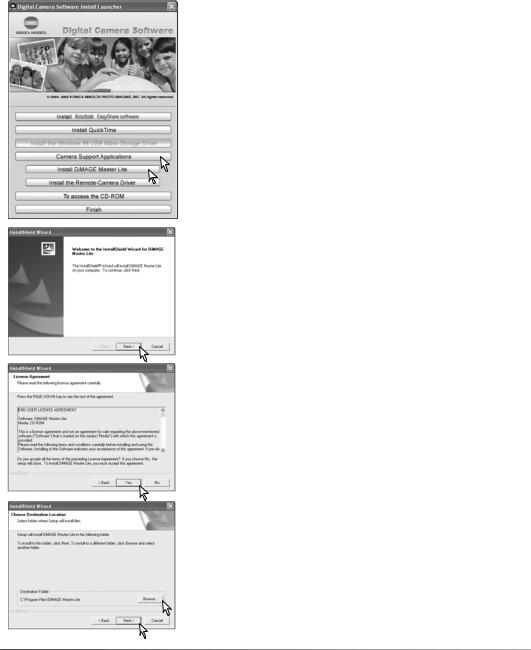
1.2 INSTALLING THE SOFTWARE - WINDOWS
In the example below, the hard disk drive is drive C. The letters designating the drives vary between computers. When using Windows 2000 or XP, the software should be installed with the Administrator privilege.
Turn on the computer to start Windows. Insert the Digital Camera Software CD-ROM into the CD-ROM drive. The launcher window opens automatically.
Click the “Camera Support Applications” button to display the installer buttons. Click the “Install DiMAGE Master Lite” button to begin installation.
The welcome window opens. Click “Next>” to continue.
The license agreement appears. If you accept the agreement, click “Yes” to continue the installation routine.
Read the entire license agreement carefully before continuing. If you do not agree to the terms, click “No” to exit the installation program.
To install the software in the default location - C:\Program Files\DiMAGE Master Lite, click “Next >.” To install the software in a different location, click browse button to display the folder selection window. Specify the directory in which to install the software.
4SECTION 1: GETTING STARTED
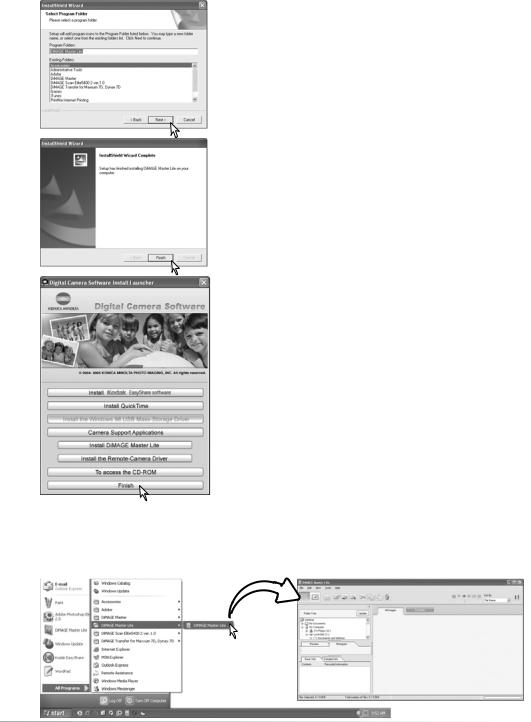
The name of the default program folder is displayed. To install the software icons in this folder, click “Next>.” Installation begins.
To install the software icons in another folder, select one of the folders listed in the existing-folders box below. Click “Next>” to begin installation.
When the software installation is completed, a message is displayed. Click “Finish.”
Click the finish button to close the launcher window.
1.3 OPENING THE SOFTWARE - WINDOWS
Select DiMAGE Master Lite from the DiMAGE Master Lite folder in the program option of the start menu. The application starts up and the Organizer window is displayed.
5
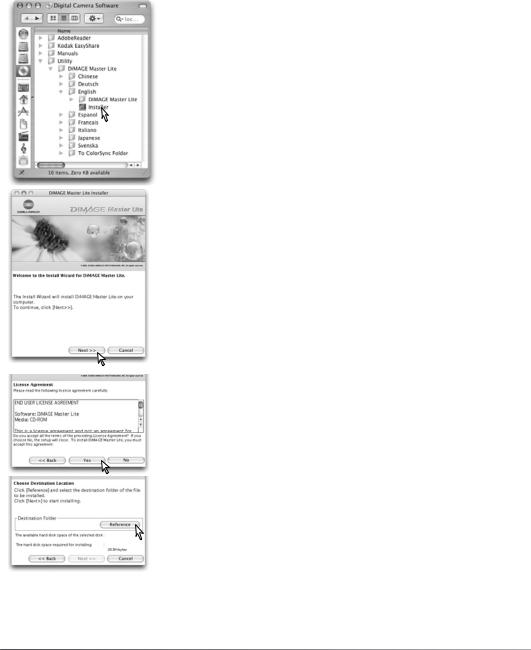
1.4 INSTALLING THE SOFTWARE - MACINTOSH
Turn on the computer to start the operating system. When the desktop appears, insert the Digital Camera Software CD-ROM into the CD-ROM drive. The CD-ROM icon appears on the desktop; double click the CD-ROM icon to open it.
Open the utility folder, the DiMAGE Master Lite folder, and then open the appropriate language folder.
Double-click on the installer icon to start the installation program.
When the installation screen appears click “Next >>” to begin the setup.
The license agreement appears. If you accept the agreement, click “Yes” to continue the installation routine.
Read the entire license agreement carefully before continuing. If you do not agree to the terms, click “No” to exit the installation program.
The location for the DiMAGE Master Lite files must be specified.
Click the reference button.
6SECTION 1: GETTING STARTED
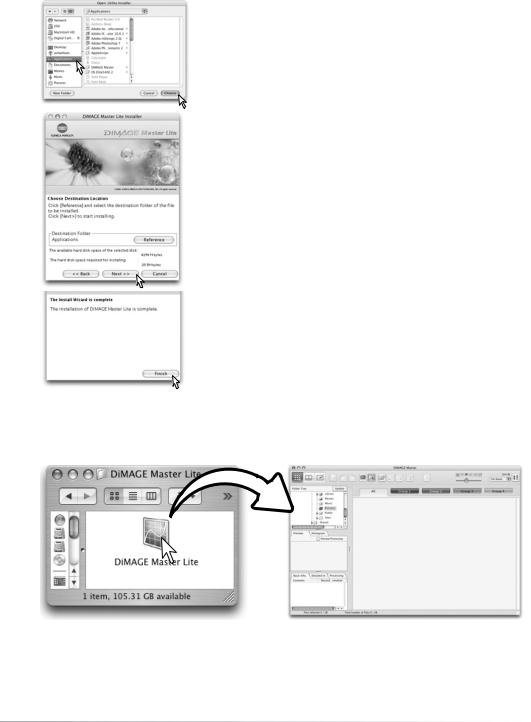
Using the folder-selection dialog box, select the location where the software should be installed. Click “Choose.”
Confirm the installation location on the installer screen. Click “Next >>” to install DiMAGE Master Lite.
A window appears when the software has been installed. Click “Finish” to exit the installer.
1.5 OPENING THE SOFTWARE - MACINTOSH
Open the DiMAGE Master Lite folder. Double-click the DiMAGE Master Lite icon to start up the application. The Organizer window is displayed.
7
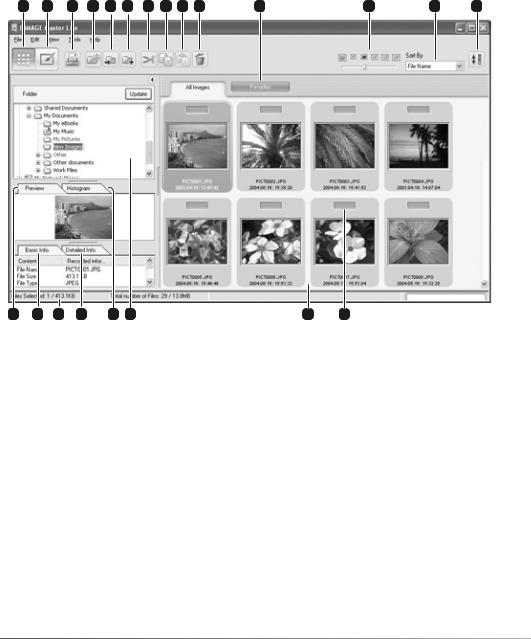
2.0 IMPORTING AND EDITING IMAGES
The section covers the basic operation of the Organizer. The Organizer allows files to be viewed and sorted. For advanced Organizer functions, see section 6.0.
2.1 ORGANIZER WINDOW
1.Organizer button
2.Photofinisher button (p. 18)
3.Print button (p. 29)
4.New folder button (p. 14)
5.Move-to-folder button (p. 15)
6.Copy-to-folder button (p. 15)
7.Cut button (p. 16)
8.Copy button (p. 16)
9.Paste button (p. 16)
10.Delete button (p. 16)
11.Favorites tabs (p. 12)
12.Thumbnail size (p. 10)
13.Sort-by menu (p. 10)
14.Reverse-order button (p. 10)
15.Preview tab (p. 9)
16.Basic-information tab (p. 9)
17.Status bar
18.Detailed-information tab (p. 9)
19.Histogram tab (p. 9)
20.Folder tree (p. 9)
21.Thumbnail display
22.Favorites selector (p. 12)
The Organizer and Photofinisher buttons switch between the main software functions. The status bar gives information on operation.
8SECTION 2: IMPORTING AND EDITING IMAGES
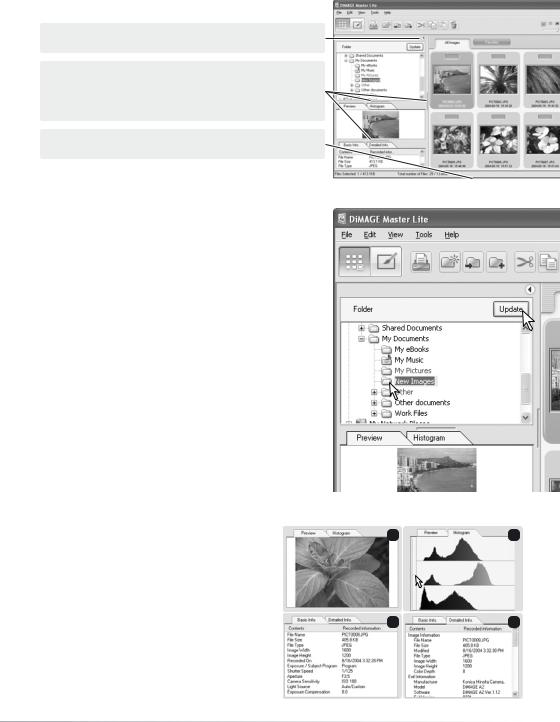
2.2 ADJUSTING THE WINDOW
The pane can be opened and closed by clicking the hide/show button.
The spacing between the folder tree, preview, histogram, and information displays can be changed by clicking and dragging the points between the displays.
The window can be resized by clicking and dragging on the frame.
2.3 LOADING IMAGE FILES
Images can be loaded directly from a digital camera or from folders located in the computer. Simply use the folder tree to select the file containing the images. For information on the camera’s folder organization and connecting the camera to the computer, refer to the camera’s instruction manual.
Click on the positive (+) nodes to display the contents of a folder. Click on a negative (–) node to hide the folder contents. The names of folders containing image and audio files are blue.
Click on the image folder to load the images. All stillimage, audio, and movie files in the folder are loaded in the thumbnail display.
If any changes are made to the folder tree, for example, the camera is disconnected from the computer, the tree can be updated. Click the update button or select the update- folder-tree option from the view menu.
2.4 PREVIEW AND INFORMATION TABS
The tabs under the folder tree provide information on a selected image. Simply click on the tab to view it.
The preview tab (1) shows the selected image. The histogram (2) displays the pixel distribution of each color channel; use the slider to change the histogram scale. The basic-information tab
(3) gives recording and file information; the display can be edited in the preferences window, see section 5.1. The detailedinformation tab (4) shows all file and image information.
9
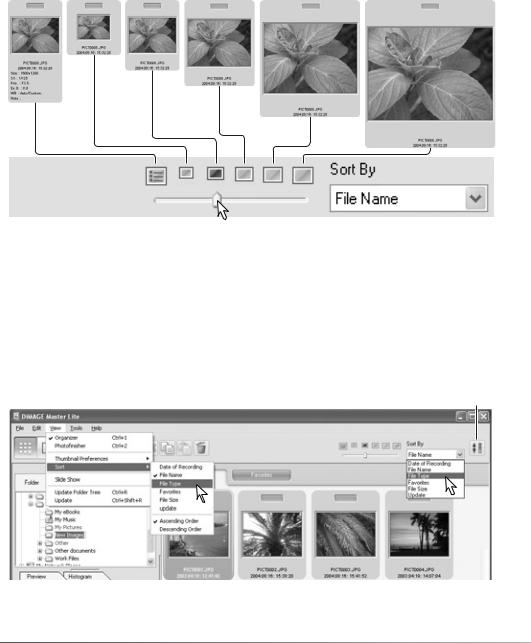
2.5 THUMBNAIL SIZE
The thumbnail size can be changed. Six sizes are available.
120x120 |
|
|
|
with data 80x80 |
120x120 160x160 |
240x240 |
320x320 |
To change the size, use the thumbnail size slider on the tool bar or highlight the thumbnail preferences option on the view menu to display the size options. On the menu, highlight and click the desired thumbnail size; the thumbnail display changes accordingly.
To edit or add a user note in the data display see section 6.4.
2.6 SORTING IMAGE FILES
Image files can be sorted by date and time of recording, file name, file type, favorites, file size, or update in ascending or descending order. To sort the displayed images, use the sort-by drop-down menu on the tool bar or the sort option on the view menu. Simply highlight the sorting category with the mouse.
Reverse-order button
The sort menu can also be used to change the display between ascending and descending order. The reverse-order button on the tool bar also changes the display order.
10 SECTION 2: IMPORTING AND EDITING IMAGES
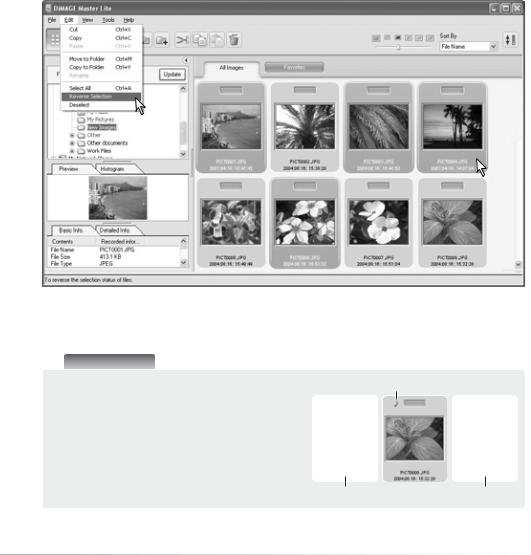
2.7 SELECTING THUMBNAILS
Click on the thumbnail borders or file icon to select a single image or use the keyboard cursor keys. To select multiple images, click and drag over the thumbnails or press and hold the control key (Windows) or command key (Macintosh) and click on each image; the selected frames become dark. To deselect an image, click on the thumbnail or icon a second time while holding the control key (Windows) or command key (Macintosh). To select consecutive images, press and hold the shift key and then click on the first and last image of the series.
To select all files, select the select-all option in the edit menu or press the control key (Windows) or command key (Macintosh) and “A” key at the same time.
The reverse-selection option in the edit menu deselects all selected images and selects all unselected images. To deselect the images, select the deselect option in the edit menu or click on the white background in the index display.
Master Notes
Some Konica Minolta cameras can record movie and audio files. Audio recordings, voice memos, and audio captions are indicated by an audio indicator. Movies use a .mov or .avi extension. QuickTime must be installed in the computer to view a thumbnail image of a movie file. See section 5.2 on how to set up DiMAGE Master Lite to open these files.
Voice memo or audio caption
Movie |
Audio recording |
11
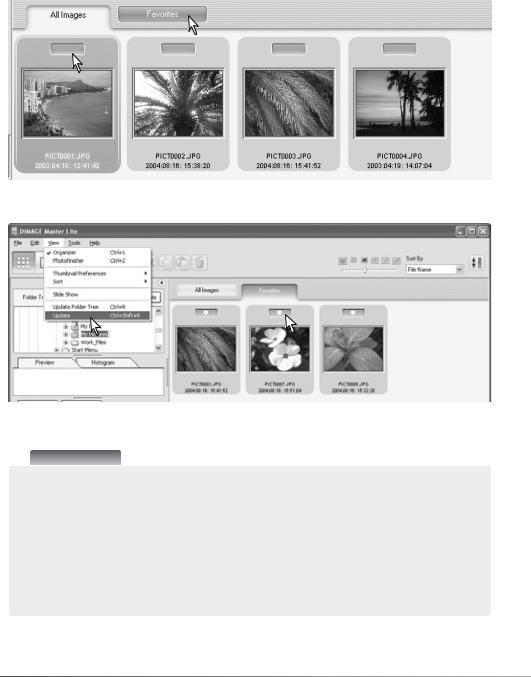
2.8 SELECTING FAVORITES
Image files can be classified as a favorite.
Simply click the favorites selector at the top of the thumbnail to add the image to the group. Click the favorites tab to view the group.
To remove an image from the favorites group, click the favorites selector again to remove the heart. Select the update option from the view menu to update the thumbnail display.
Master Notes
Files can be added to favorites by clicking on the thumbnail image and dropping it onto the favorites tab. Dropping it onto the all-images tab removes it from favorites.
The full version of DiMAGE Master uses a more sophisticated method of classifying images. Four tabs, which can be named and color coded by the user, are used to organize image data. The groups can be copied to different folders. For more on DiMAGE Master, visit us on the web at:
North America: http://kmpi.konicaminolta.us/
Europe: http://www.konicaminoltasupport.com
12 SECTION 2: IMPORTING AND EDITING IMAGES
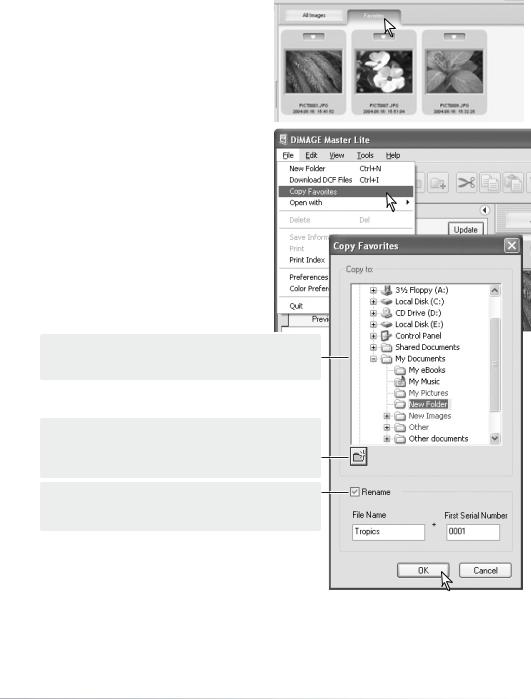
2.9 COPYING FAVORITES
A copy of the images in favorites can be made. Click the favorites tab to display the group.
Select the copy favorites option from the file menu.
In the copy-favorites window, select the destination folder in the folder tree.
A new folder can be created in this window. Click on the location for the new folder and click the new-folder button; a folder appears on the folder tree. The folder can be renamed.
To rename the files, click the rename check box. Enter the new file name and the first serial number of the group.
Click the OK button to copy the group to the designated folder. If an image has an attached audio or thumbnail file, those files are also copied.
13
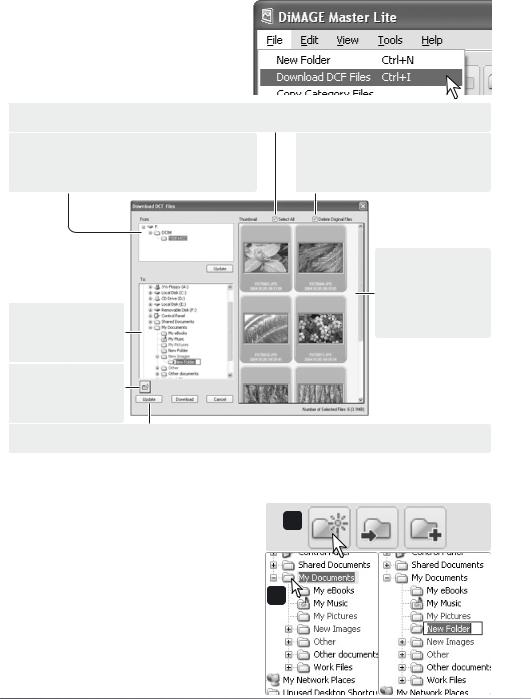
2.10 DOWNLOADING CAMERA FILES
Camera files can be downloaded directly to the computer hard drive. Connect a camera to the computer using a USB cable and select the Download-DCF-files option from the file menu. The download dialog box opens. This options also downloads images from a card reader.
Click the select-all check box to copy all images to the computer.
Select the file location on the camera’s memory card. If the camera is changed, use the update button to update the folder tree.
Click the delete-original-files check box to erase the downloaded files from the camera.
Select the file destination in the computer.
The new folder button adds a folder to the folder tree.
The update button updates the computer’s folder tree.
Use the index display to select specific files to download. See section 2.7 on how to select files.
Confirm the settings and then click the download button to complete the operation. The cancel button closes the window without downloading any images.
2.11 CREATING FOLDERS
New folders can be created to store images. Click on the desired location for the new folder. In this example the new folder is placed in the My Documents folder (1).
Click on the new-folder button (2) on the tool bar or select the new-folder option from the file menu. The new folder is created in the specified location. The folder name can be changed with the keyboard.
14 SECTION 2: IMPORTING AND EDITING IMAGES
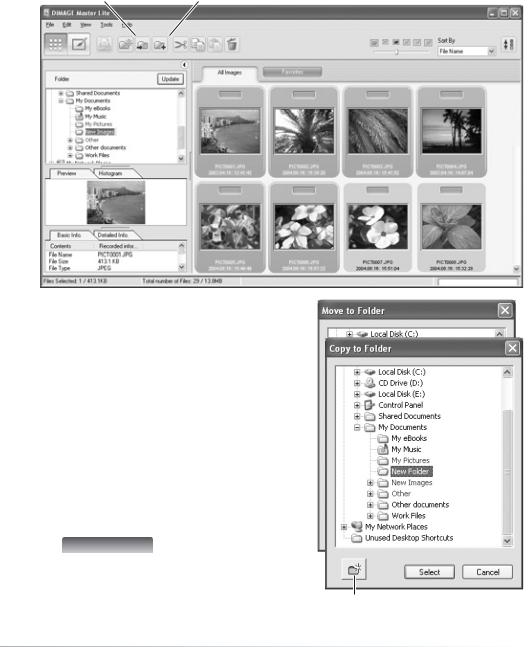
2.12 COPY & MOVE FILES TO ANOTHER FOLDER
Multiple files can be copied or moved from one folder to another. Click on the thumbnail borders to select the images. To select images, see section 2.7.
Move-to-folder button |
Copy-to-folder button |
After selecting the files, click on the move-to-folder button or copy-to-folder button on the tool bar or select the corresponding option from the edit menu. The select-destination window opens.
In the select-destination window, click on the destination folder. Click the select button to move or copy the specified images to the designated folder. If an image has an attached audio, or thumbnail file, those files are also copied.
A new folder can be created in the select-destination window. Click on the location for the new folder and click the new-folder button; a folder appears in the folder tree in the window. The folder can be renamed.
Master Notes
Files can also be copied by clicking on the thumbnail and dragging it to a folder in the folder
tree.
New folder button
15
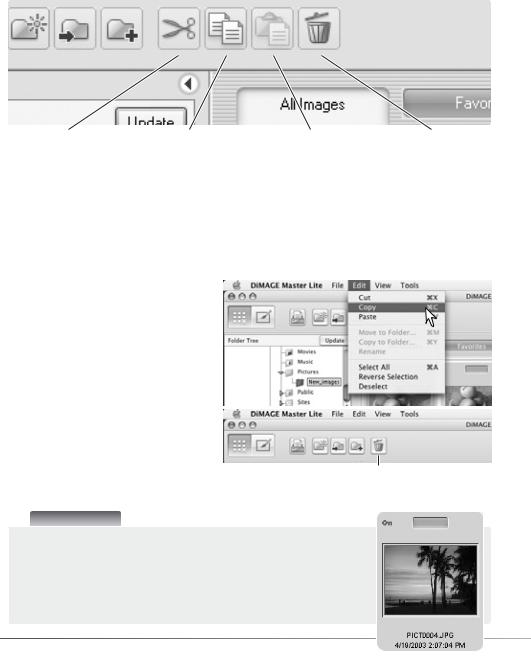
2.13 CUT, COPY, PASTE, AND DELETE - WINDOWS
The tool bar and edit menu can be used to cut, copy, and paste folders and files. The delete button and delete option on the file menu erases files. These functions affect any audio or thumbnail files attached to an image. The delete key on the keyboard also deletes folders and images.
Cut button |
Copy button |
Paste button |
Delete button |
Select the folder or images to be moved. Click the cut or copy button. The display does not change when a cut is made until the paste has been completed. Click on the new location for the folder or images. Click the paste button to complete the operation.
When a delete command is given, a confirmation screen appears. Clicking the yes button executes the command and deletes the data, clicking the no button cancels the delete command.
2.14 CUT, COPY, PASTE, AND DELETE - MACINTOSH
The cut, copy, and paste functions are located in the edit menu. They can be used for editing file and folder names, but they cannot be used to cut, copy, or paste files and folders.
The delete button on the tool bar or pressing the command and delete button on the keyboard erases files and folders. When a delete command is given, a confirmation screen appears. Clicking the yes button executes the command and deletes the data, clicking the no button
cancels the delete command.
Delete button
Master Notes
Images locked with the camera have the lock indicator displayed on the top left corner of the thumbnail. To unlock the image in Windows, right click on the file icon in the hard drive and select the properties option; uncheck the read-only attributes. In Macintosh, highlight the file icon in the hard drive and press command + i; uncheck the lock option in the dialog box.
16 SECTION 2: IMPORTING AND EDITING IMAGES
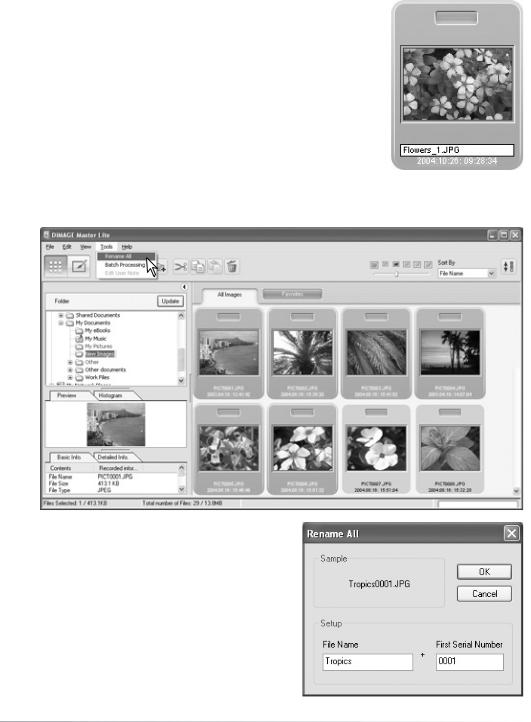
2.15 RENAMING SINGLE FILES
Single files can be renamed in the thumbnail and details displays. When rewriting file names, always include the original file extension.
Select the image. Click on the file name to activate the cursor. Use the keyboard to change the file name.
2.16 RENAMING MULTIPLE FILES
Multiple files can be renamed. See section 2.7 on how to select files.
After selecting the images to be renamed, select the rename-all option in the tool menu. The rename-all window opens.
In the rename-all window, enter the new file name and the first serial number. The first file name in the series is displayed in the sample area.
Click the OK button to change the file names of the selected images.
17
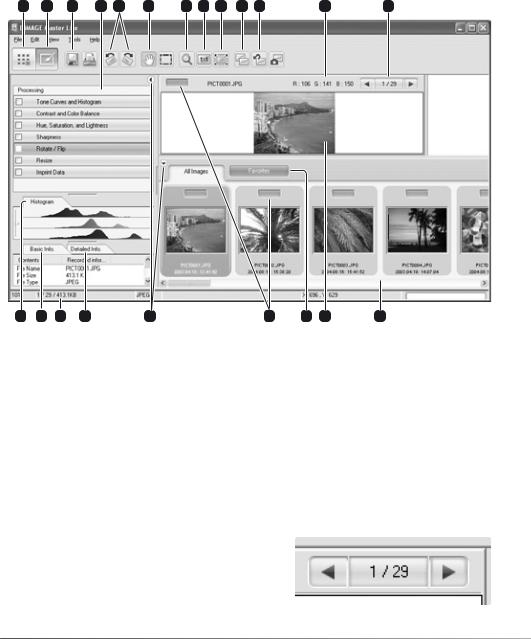
3.0 BASIC IMAGE PROCESSING
The section covers the basic operation of the Photofinisher. Images can be processed to improve them. For advanced Photofinisher functions, see section 7.0.
3.1 PHOTOFINISHER WINDOW
1.Organizer button (p. 8)
2.Photofinisher button
3.Save button (p. 28)
4.Photofinisher tool pane
5.Rotate buttons (p. 20)
6.Grab tool (p. 19)
7.Magnification tool (p. 19)
8.Actual-size button (p. 19)
9.Fit-to-window button (p. 19)
10.Comparison display button (p. 26)
11.Undo-all button (p. 26)
12.RGB display (p. 20)
13.Frame selector
14.Histogram tab (p. 9)
15.Basic-information tab (p. 9)
16.Status bar
17.Detailed-information tab (p. 9)
18.Hide/Show pane button (p. 9)
19.Favorites selector (p. 12)
20.Favorites tab (p. 12)
21.Preview display
22.Thumbnail display
The Organizer and Photofinisher buttons switch between the main software functions. The status bar gives information on operation.
The frame selector shows the number of the displayed image as well as the total number of images in the folder. Clicking the arrows displays the previous or next image.
18 SECTION 3: BASIC IMAGE PROCESSING
